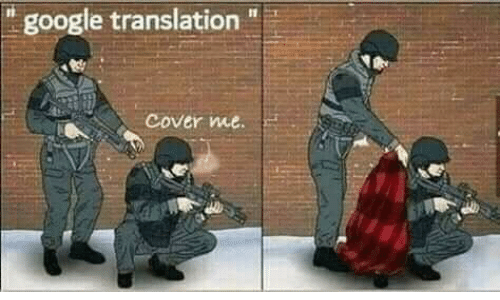%20(1).png?width=740&name=translation%20agency%20vs.%20Google%20Translate%20Plugin%20(1)%20(1).png)
What is the difference between professional translation providers and free machine translation plugins? Can you use free machine translation plugins for commercial use?
The purpose of this article is for you to understand the differences between professional translation services and free Machine Translation solutions.
Even though we are a translation company, we will focus on showing the positive sides of both solutions. Each of them is suitable for different purposes. The comparison will be based on the factors listed below:
• Translation Time;
• Availability of Translation Services;
• Translation Quality;
• Translation Content Credibility.
In the end, we will present a few scenarios. In each of them, only one solution will be optimal.
What this article is not going to compare is human translation and paid, custom made Machine Translation output followed by professional post-editing step.
Let's start from the beginning. Automated translation plugins like Microsoft Translate or Google Translate are based on Machine Translation (MT) technology. MT technology uses statistics, language rules, AI (Artificial Intelligence) or a mix of above.
The job of Machine Translation is to change content from one language into another. There is no human interaction involved, except for setting up the system. The technology is based on the work of translation engines, which use already-translated content.
For example, in order to create an engine that can be used for English - Spanish MT, millions of previously translated English - Spanish segments are needed. A segment is the smallest, logical portion of a text, for example a sentence or an item of a bullet point list.
.png?width=481&name=machine%20translation%20into%20Spanish%20(1).png)
The engine is the brain of MT. It can use statistics, a collection of linguistic rules, AI (Artificial Intelligence) or a mixture of the above in order to mimic the translation on new sentences. In a nutshell, what is put into the engine will shape the quality of Machine Translation output. A basic quality AI-based engine requires around one million bilingual segments in order to "learn".
The free solutions are mostly based on collections of bilingual documents found on the Internet or contributed by volunteers. All content that goes through the free Machine Translation tools is no longer private.
In most cases, the plugins are very easy to implement, for example, the Google Translate plugin for WordPress. You only need a few configuration steps and Machine Translation for 100+ languages is available on your website. It really takes very little time to set up a free MT plugin.
To leave your competitors behind, you need perfect timing. If you wish to start a campaign at a given point in time, nothing should stand in your way. Let's check how fast you can have your content translated with the help of a translation company.
One linguist translates, in average, 3,000 words within 8 working hours. This applies to manuals, documentation, help documentation or websites that are not too overloaded with marketing. The same time is needed to translate about 2,500 words of marketing translation or websites with heavy marketing.
With regard to programming translation and UI, the number of translated words is even smaller. An average freelance translator needs about one work day to translate 2,000 words concerning software.
The time needed for one linguist to translate a given number of words does not equal the time needed for a translation company to finish a localization project.
First of all, the majority of translation companies work according to the industry standards like ISO 17100:2015. Standards define translation service as consisting of the translation step followed by the bilingual examination of source text against target text, called revision.
This step is conducted by a separate linguist. An average daily reviser's capacity is about 6,000 words of documentation, manuals or websites with light marketing.
Respectively, that is 5,000 words for marketing and heavy marketing websites and 4000 words for software translation and UI.
Moreover, professional translation companies provide a number of different services supporting your localization efforts, like for example:
• Review;
• Proofreading;
• File Engineering;
• Linguistic Testing;
• Voice Over;
• Subtitling.
All these localization building blocks add up and define the time needed for your content to be ready for local market.

Free MT plugins translate in the blink of an eye. The actual speed of MT translation depends on a few factors: Language pair, formatting, and engine size, but the average speed of noncommercial MT is 3,000 words per minute.
It generates 1,440,000 words per regular nine-to-five work day. And, since the machines don't sleep, the numbers of translated words per 24 hours is insanely huge.
Now that we know how fast we can get the content translated, let's check the availability of professional translation services and Machine Translation solutions.
How many translation companies are there?
After typing in the phrase 'translation services provider' in the browser, you get 92,100,000 results. What is the availability of translators for particular languages?
According to the Ethnologue: Languages of the World, there are at least 7,117 living languages in the world.
%20(1).png?width=534&name=languages%20for%20translation%20(2)%20(1).png)
Are there enough translators and interpreters to support the growing need for translation as content production increases? The most in-demand translation languages are Spanish, French, Portuguese, German, Arabic, Chinese Simplified, Japanese, Italian and Korean and Russian.
But what about the remaining 7,107 languages? This is a case for professional localization companies. Translation companies cooperate with freelance translators through Vendor Management Departments.
The departments are managed by qualified professionals who find, classify, train, and allocate the best translation talents to localization projects.
When working according to ISO 17100:2015 standards, there is no space for a random, unverified linguist to enter the company's pool of linguists. Consequently, all the translation projects are assigned to verified, professional subject-matter experts, native speakers of the translation language.
As already mentioned, MT technology is based on the work of translation engines, which use already-translated bilingual segments. There are language pairs supported by billions of translated documents available online and, therefore, these are supported by MT. However, there are language pairs for which there is little content and therefore these are not supported by free MT solutions.
Right now, Google Translate covers 109 languages and Microsoft Translator 73.
Related content: 15 Languages for Translation That You Should Know About
First of all, what a good translation company will help you with, and MT will not, is preparing your content for localization.
Some basic conditions need to be met in order for the content to be ready for translation. Internationalization is fundamental while considering going global with your organization.
Related content: A Guide to Understanding Translation and Localization Terminology
It is crucial, for example, in software translation. One example is using Unicode for fonts in order to avoid content corruption after translation. It is connected with the local diacritics (marks put above, below, through or on a letter).
Internationalization is also connected with the meaning. Any cultural or social references may be difficult to translate. Some of them may also be offensive for local audiences. This is especially important with regard to high visibility content like slogans, marketing banners, or your website’s Home page.
Last but not least, there are situations where there are errors in the source content. When a translation professional handles your content and spots a possible error in the source language, they report it to you directly and await your clarification. After the query is answered, the linguist translates the text accordingly, sometimes going against the original text.
Machine Translation will simply transfer the meaning of a text into another language without going into too much detail with regard to possible consequences.

The quality of the free MT solutions is getting better and better, but it is still prone to errors. With automated translation done by machine, there is no guarantee that the translated content says exactly the same thing as the original content.
The sentences may be translated correctly, but they may make no sense to your clients. Some hilarious examples of MT fail translations go viral when spotted by the end-users.
Imagine what an unattended machine can do with homonyms in your text. Homonyms are words that have the same spelling and usually sound alike, but have different meanings e.g.: 'match' (to pair similar items / a stick for making a flame) or 'a bat' (a tool used to hit a ball / a nocturnal flying mammal).
Let's use a sentence from a video game as an example.
The player's task is to put a bat (a tool used to hit a ball) in a cave. However, the translated instructions say to put a bat (a nocturnal flying mammal) in the cave. Such an error is very likely to happen while using MT.
As explained earlier, machines learn on the basis of the already-translated content that their engines were fed. There will be hundreds of sentences including the word 'cave' and 'bat' (referring to the animal) with which the machine is familiar.
Consequently, the machine will learn to associate the meaning of the word 'bat' with the notion of 'stick', whenever the term is surrounded by words like 'hit' or 'player'. It is therefore obvious for the machine to choose one meaning over another. In consequence, the translation may turn out to be completely puzzling for the user.
However, machines don't produce human error. It is very unlikely for the MT to produce a spelling error or a typo.
%20(1).png?width=540&name=translation%20quality%20(1)%20(1).png)
As mentioned earlier, according to ISO 17100:2015 standards, human translation is followed by a step called revision.
The revision stage is a bilingual examination of the source content against the translation. In this stage, any translation errors are corrected, and the text is finetuned before the finalization.
Translation companies work closely with client reviewers. Client reviewers are the people who know the product and the company voice. They also speak the language that the text was translated into. These can be local partners or other bilingual members of the team.
Whenever client reviewers have feedback to share with the linguists, the localization project manager is there to assist. The feedback is implemented and checked for consistency. The localization team updates project instructions and makes sure that the feedback is followed in all future translations.
.png?width=566&name=unique%20marketing%20content%20(1).png)
Introducing your product or concept on a new market often brings new terminology into the game. Companies strive to distinguish themselves from the competition with the use of their unique voice. If you don't want to produce look-alike marketing campaigns, establish rules of your own, unique message.
Translation companies usually start localization projects by creating a Translation Style Guide and Terminology.
A Translation Style Guide is a collection of linguistic guidelines and recommendations. It does not contain grammar rules. Rather, it defines what writing style should be used and prescribes preferred resources e.g.: a glossary. This document is created together with the client.
Terminology, on the other hand, is the list of terms taken from the source content. Terminologists analyze the meaning of a term in the source language and find the best equivalent in the target language. It is crucial with regard to pioneering solutions and innovations. Unique terminology is what distinguishes the message of one brand from another.
If you don't like the translated content produced by Google Translate free MT solution, you can suggest an edit to the translated version. But how do you know that you don't like the translation if you don't know the language? In this case, your customers may be the ones who spot the error.
The issue can immediately go viral and it can give you bad press. With the free MT solutions, there is no option for engine customization. Even if you edit the translation or provide feedback to Google, your input is just a tiny contribution to the billions of translated segments that shape the overall performance of the engine.
Machine Translation can be edited by professional linguists. Such service is called post-editing, but it is not a part of free MT plugins. There are professional post-editors offering this service. However, they are most likely to refuse the post-editing of a poor-quality translation coming from free MT plugin.

There are scenarios in which the best solution is to use a free Machine Translation. For example, if you are writing a friendly note to your colleague from another country in their native language.
The text may contain errors, but I am sure they will still appreciate it. Especially if you send the translation in handwriting.
If you need to get some general information in another language fast (for non-commercial use) the MT is, again, the best solution.
Machine Translation is also perfect for translating real-time user-generated content, like comments, reviews, or social media posts.
Free MT plugins are good for a quick translation that doesn't need to be perfect. However, professional localization is never that easy.
The success of your product launch on a new market is, and for many more years will remain, impossible without human input.
As you can see, the speed of translation is inevitably better when conducted by MT. Quality and flexibility are still on the human translator's side. It would be great to combine those two, right?
Fortunately, it is possible. And this service, which is provided by professional translation companies, is called Machine Translation Post-Editing (MTPE).
Now that you know what you can get from a translation agency vs. a Google Translate Plugin, it's time for you to decide. And if you decide to combine those two and go for Machine Translation Post-Editing, it's crucial to know how to find the right translation partner for MTPE.
It's also important to make sure you can get your content translated fast without compromising the translation quality. And the last thing, make sure you choose the right service from the start so that you meet your time-to-market without overspending on translation.
Recommended articles:
How to Reduce Turnaround Time for Content Translation
+1 857 777 5741 ext. 203 (business inquiries)
+1 857 777 5741 ext. 205 (career inquiries)
Trylinskiego 16, 10-683
Olsztyn, Poland
Copyright ATL 2025. All Rights Reserved.